Key takeaways:
- Different pricing strategies can influence reader perceptions; higher prices may imply quality while lower prices can boost initial readership.
- Understanding target audience demographics and preferences is essential in setting effective book prices.
- Researching competing titles helps authors understand market positioning and set competitive prices.
- Regularly monitoring sales and reader feedback allows authors to adjust pricing strategies for better alignment with market trends.
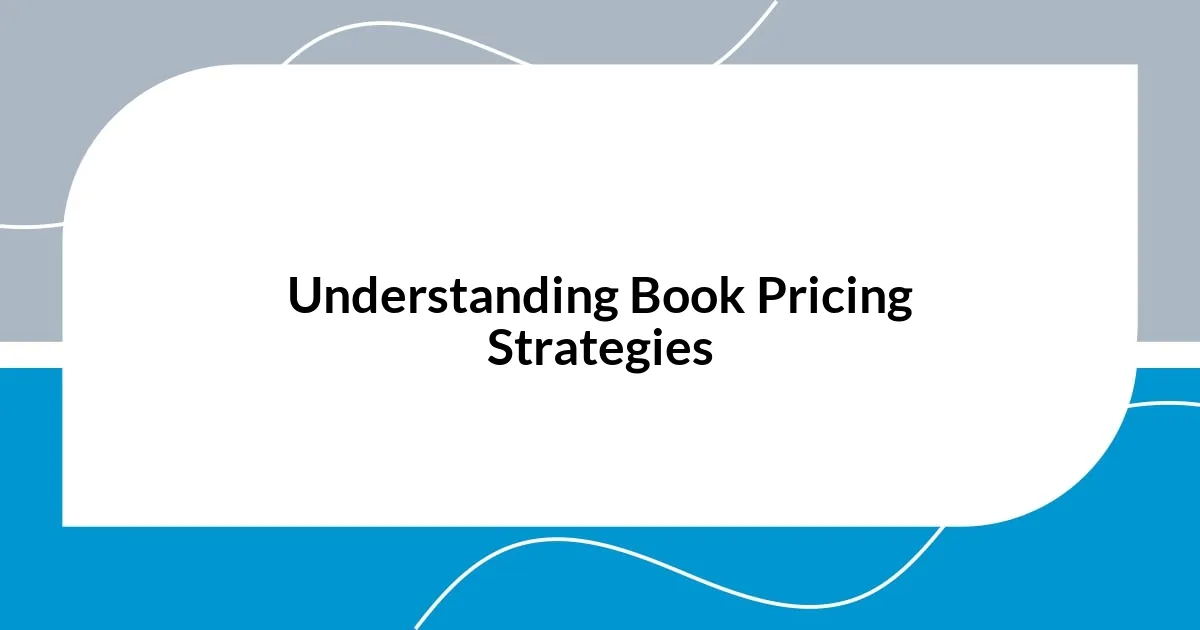
Understanding Book Pricing Strategies
Understanding book pricing strategies is like navigating a complex landscape—there’s no one-size-fits-all approach. I recall my first experience setting a price for my debut novel; I was torn between what I thought I’d earn and what readers might actually pay. It hit me—how do I value my work in a way that resonates with potential readers?
Different pricing strategies can evoke various reader reactions. For instance, I’ve noticed that a lower price can attract more readers initially, but does that truly reflect the worth of my work? Sometimes, I wonder if a higher price might set a perception of quality, encouraging readers to view my book with a sense of value and prestige.
In my journey, I’ve also experimented with limited-time promotions, and the excitement they generate is palpable. Offering a book at a discount can create urgency among readers, but it also raises questions: Am I devaluing my work in the long run? Finding the sweet spot between accessibility and value is an ongoing struggle that many authors face, and I can’t help but feel that pricing is as much an art as it is a science.
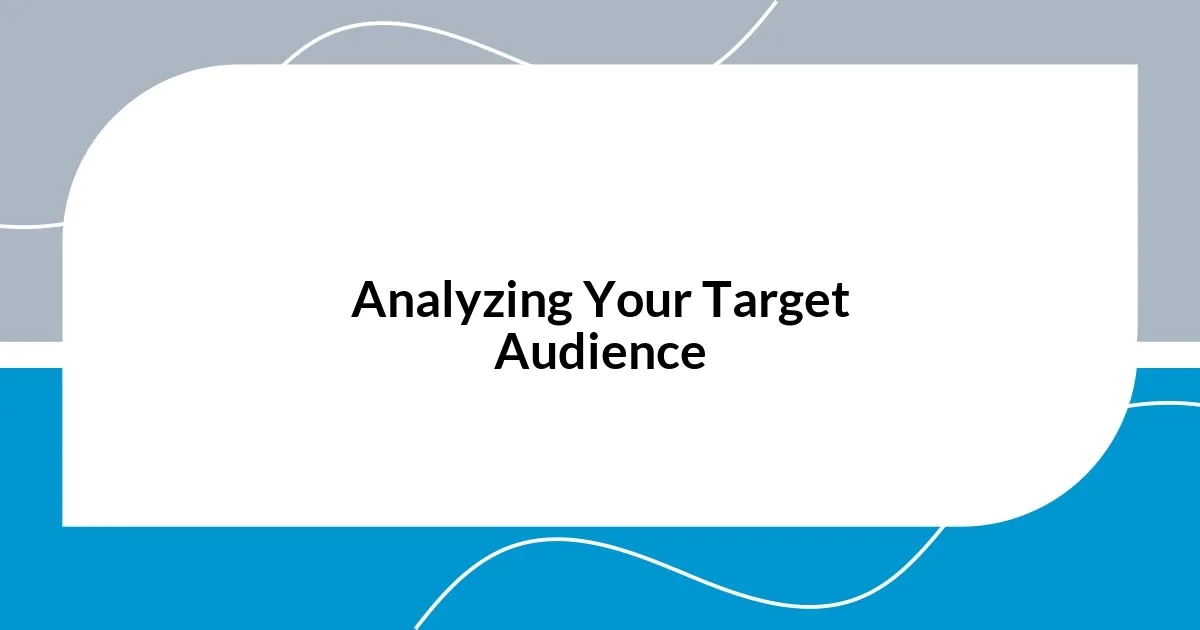
Analyzing Your Target Audience
Understanding your target audience is crucial when setting book prices. Through my own experiences, I’ve learned that knowing who will read my book can significantly influence how I price it. For example, my first thriller was aimed at passionate genre fans who are often willing to pay a premium for a gripping story. This insight led me to set my initial price higher, which ultimately paid off as I attracted a dedicated readership.
Many authors, however, overlook the importance of demographics and preferences. When I conducted surveys, I discovered that my readers favored e-books over print. This prompted me to adopt a more competitive price for the digital format while maintaining a premium for the print edition. Tailoring my pricing strategy based on audience preferences not only boosted sales but also made my readers feel valued and understood.
Additionally, engaging with readers on social media has opened my eyes to their expectations. I remember running a poll asking how much they were willing to spend on a new release, and the results were enlightening. It reinforced the idea that my target audience’s feedback could illuminate my approach to pricing, ensuring that it aligns with their perceptions and willingness to pay.
| Demographic Factors | Impact on Pricing |
|---|---|
| Age Group | Younger readers may prefer lower prices, while older audiences might value quality over cost. |
| Reading Habits | Frequent readers are often willing to invest more in books they love. |
| Geographical Location | Local economic conditions can affect what buyers are willing to spend. |
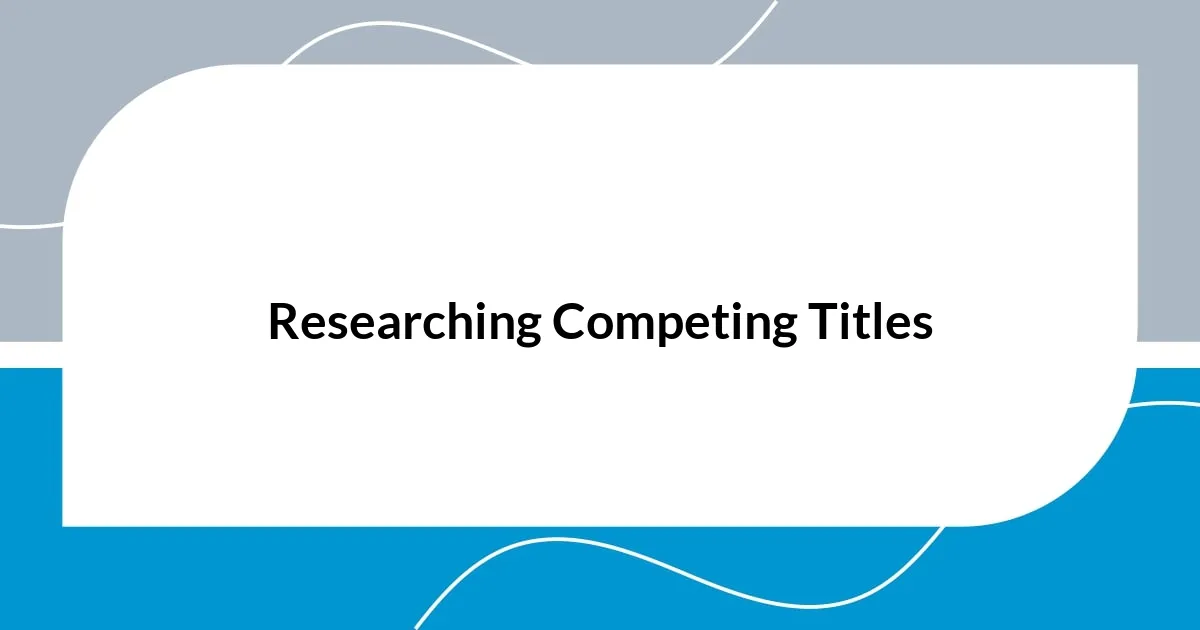
Researching Competing Titles
When I set out to research competing titles, I realized how invaluable this step is in shaping my pricing strategy. One day, I spent hours scrolling through online bookstores, comparing books similar to mine. It was both enlightening and humbling—I found titles with similar themes priced anywhere from $0.99 to $29.99! This variability made me appreciate that the market isn’t just about numbers, but also about perception and positioning.
Here are some critical factors I took into account during my research:
- Genre Comparison: Understanding pricing norms within my genre helped me gauge where my book might fit.
- Author Popularity: Noting how bestselling authors price their books provided insight into perceived value and reader expectations.
- Book Length: Analyzing how the size of the book affects its price helped me determine a fair rate based on word count and content depth.
- Publication Type: Whether traditionally published or self-published, pricing strategies can differ drastically, often reflecting the distribution channels.
In one case, I noticed that a debut author in my genre had a lower price, which surprisingly generated significant interest. Seeing that made me consider the trade-off between being competitive and maintaining the perceived value of my work. I felt a mix of camaraderie and rivalry, recognizing that we are all navigating similar challenges in this beautiful yet complex literary landscape.

Setting Your Book’s Value
Setting my book’s value has always felt like walking a tightrope; it requires a delicate balance between my perception of its worth and what readers are actually willing to pay. One time, I chose a price that felt right to me, only to find it didn’t resonate with my audience. Reflecting on that experience taught me the importance of testing different price points and being flexible. Isn’t it fascinating how our own attachment to our work can sometimes cloud our judgment?
As I’ve explored different pricing strategies, I often think about the emotional connection readers have with books. For instance, when I released a heartfelt memoir at a modest price, the feedback was overwhelmingly positive. Readers expressed appreciation for the accessibility, which inspired heartfelt conversations. It made me realize that sometimes, setting a lower price can foster a stronger bond with my audience, making them feel like they’re part of a shared experience rather than just buyers in a transaction.
In essence, I’ve also learned that my approach shouldn’t be static. The publishing landscape is continually evolving, and so are reader expectations. I once decided to temporarily reduce the price of my self-help book during a promotional campaign. The response was incredible—sales skyrocketed, and the book gained traction in various communities online. It served as a powerful reminder that being in tune with my readers can lead to opportunities I hadn’t even considered. What strategies have you tried to better understand and connect with your audience?
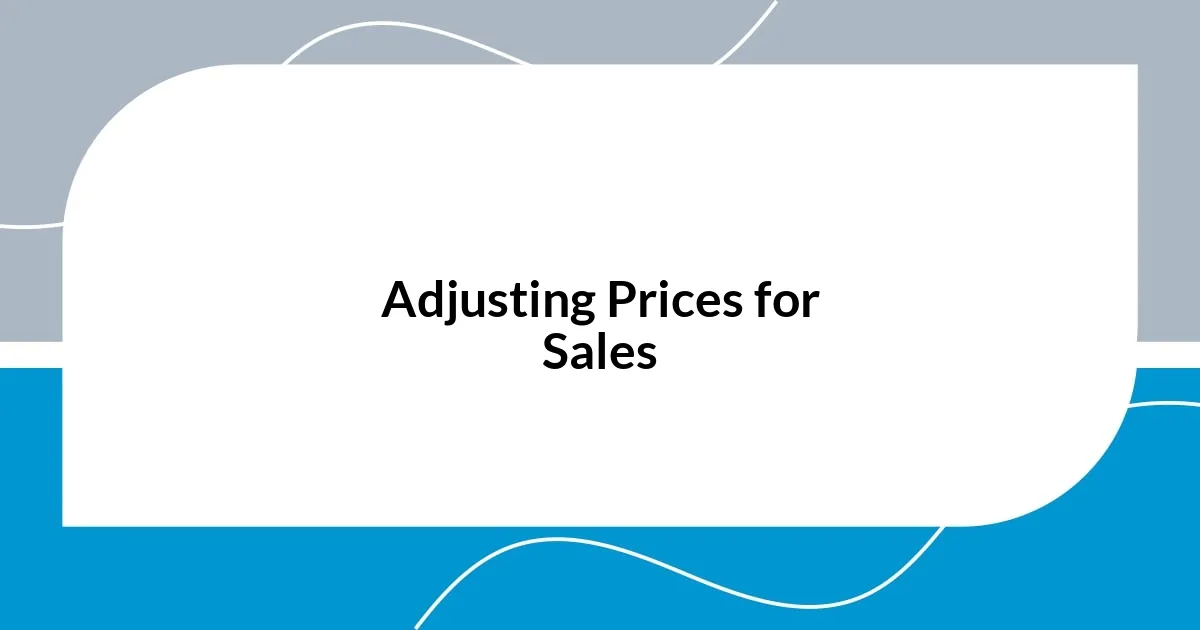
Adjusting Prices for Sales
Adjusting prices for sales has become an art form in my journey as a writer. I vividly remember launching a limited-time promotion on my fantasy series—dropping the price to just $1.99. The buzz it generated was exhilarating! Readers flocked in droves. The surge in visibility not only boosted sales but also ignited a wave of reviews that elevated my book’s status. Adjusting the price in this way made me reflect: how often do we underestimate the power of a strategic discount?
I’ve also experimented with bundling my books during sales, primarily because I wanted to offer value while increasing overall sales volume. By pricing a collection at a fraction of what each title would cost individually, I found I could introduce my work to new readers. I recall the moment when a reader reached out, sharing how they found my bundled set inspiring—a reminder that thoughtful pricing can create meaningful connections. Have you ever considered how a small adjustment might unlock opportunities for engaging your audience?
During holiday seasons, I tend to revisit my price strategies again. One winter, I ran a special to coincide with the holidays, offering a ‘gift-for-a-friend’ discount. Not only did this approach lead to an uptick in sales, but I also loved seeing how readers thought outside the box. It turned my books into gifts that spread joy rather than just transactions. This interplay of price and reader engagement is something I continuously adapt. How do your pricing strategies evolve in sync with your marketing efforts?
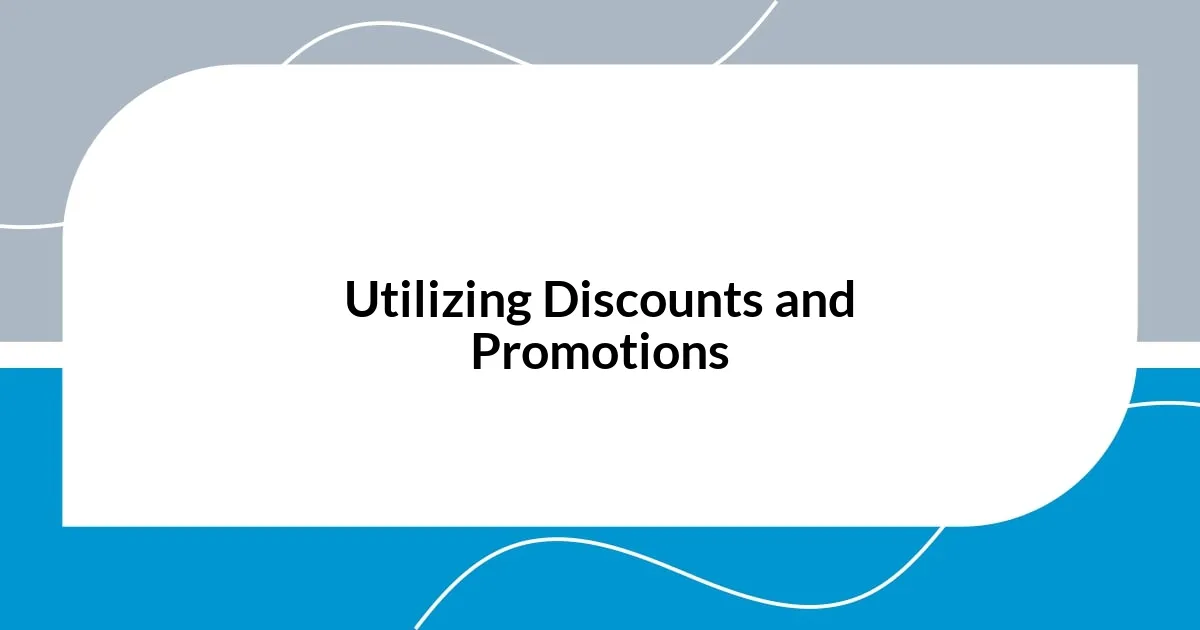
Utilizing Discounts and Promotions
Utilizing discounts and promotions has been a game changer for me in reaching new readers. I recall one instance where I decided to offer my debut novel for free on a platform for just three days. The response was overwhelming! I watched as downloads surged, and I received messages from readers who hadn’t been exposed to my work before. It made me wonder: how many stories can remain hidden without the nudge of a promotion?
I’ve also played around with seasonal promotions that align with special events or holidays. Last summer, I created a “Summer Reads Sale,” offering discounts on my lighter fiction titles. The result? A spike in engagement, with people sharing their reading lists on social media. It felt rewarding to see how my books became part of their summer plans. Have you ever thought about how your titles could fit into seasonal themes to boost visibility?
One tactic I cherish is the “limited-time offer.” I once experimented with a countdown sale, where I gradually increased the price after each week. Many readers rushed in during the first few days to grab my book at a lower price, creating a sense of urgency. It was enlightening to observe how this urgency drove not just sales, but conversations about my book. I’ve learned that a well-timed promotion can create excitement and buzz, reminding me of the importance of positioning my work thoughtfully. What methods have you found effective in generating that kind of excitement around your own writing?
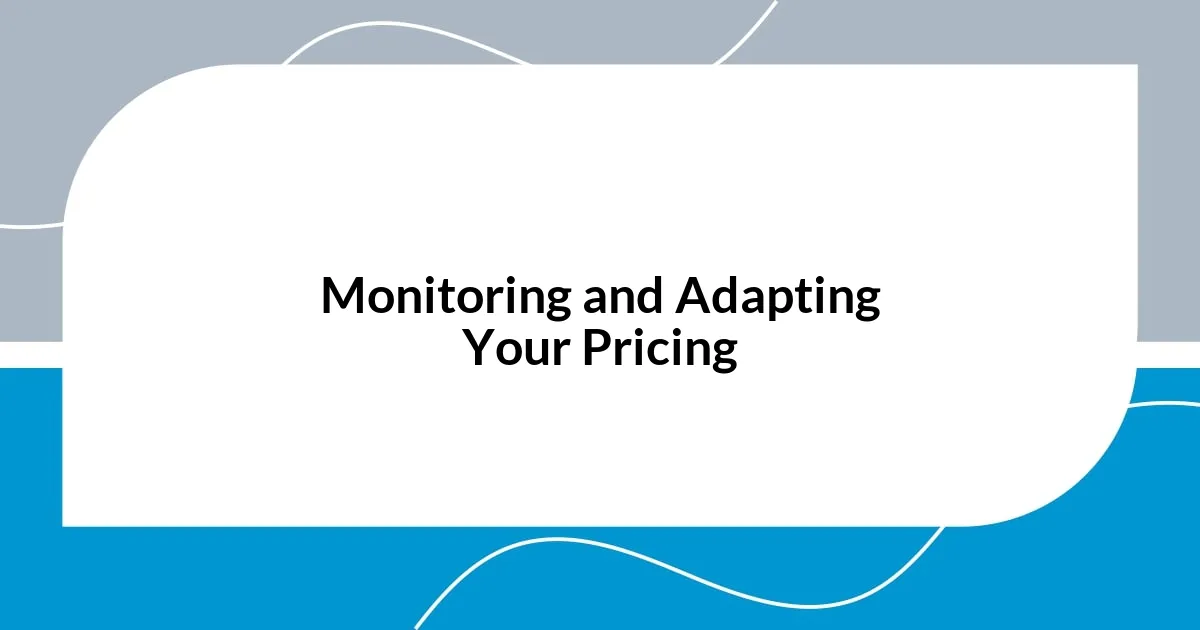
Monitoring and Adapting Your Pricing
To truly master the art of pricing, I firmly believe in constant vigilance. Monitoring my book sales stats, along with reader feedback, has become second nature to me. I remember a time when I noticed a sudden drop in sales after initially enjoying a healthy flow. It led me to question whether my pricing was becoming stale or misaligned with reader expectations. Isn’t it fascinating how our initial successes can sometimes cloud our judgement over time?
Adjusting pricing isn’t just about numbers; it’s also about being responsive to external factors. For instance, I once lifted the price of one of my books after it gained traction through word-of-mouth buzz at a local book club. I was surprised by how quickly my audience reacted. They appreciated the value I placed on my work and, in return, drove even more interest. Have you considered how the momentum created by reader engagement can inform your pricing strategies?
Moreover, embracing a flexible mindset can lead to unexpected growth. During a recent market trend where similar titles skyrocketed in popularity, I decided to experiment with a strategic price increase. The outcome? Not only did my sales hold steady, but I also saw a newfound respect for my work with readers willing to pay a bit more. This experience reaffirmed my belief that adapting to market changes isn’t just beneficial; it can be pivotal. How do you plan to stay in tune with the ever-evolving dynamics of the publishing world?